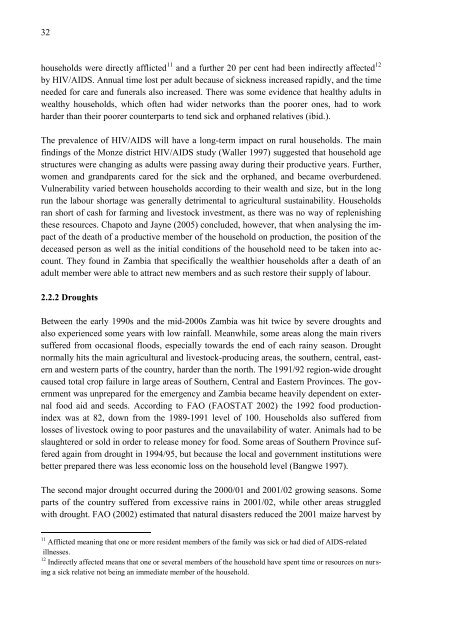Rural Income Generation and Diversification - A Case Study ... - Doria
Rural Income Generation and Diversification - A Case Study ... - Doria
Rural Income Generation and Diversification - A Case Study ... - Doria
Create successful ePaper yourself
Turn your PDF publications into a flip-book with our unique Google optimized e-Paper software.
32<br />
households were directly afflicted 11 <strong>and</strong> a further 20 per cent had been indirectly affected 12<br />
by HIV/AIDS. Annual time lost per adult because of sickness increased rapidly, <strong>and</strong> the time<br />
needed for care <strong>and</strong> funerals also increased. There was some evidence that healthy adults in<br />
wealthy households, which often had wider networks than the poorer ones, had to work<br />
harder than their poorer counterparts to tend sick <strong>and</strong> orphaned relatives (ibid.).<br />
The prevalence of HIV/AIDS will have a long-term impact on rural households. The main<br />
findings of the Monze district HIV/AIDS study (Waller 1997) suggested that household age<br />
structures were changing as adults were passing away during their productive years. Further,<br />
women <strong>and</strong> gr<strong>and</strong>parents cared for the sick <strong>and</strong> the orphaned, <strong>and</strong> became overburdened.<br />
Vulnerability varied between households according to their wealth <strong>and</strong> size, but in the long<br />
run the labour shortage was generally detrimental to agricultural sustainability. Households<br />
ran short of cash for farming <strong>and</strong> livestock investment, as there was no way of replenishing<br />
these resources. Chapoto <strong>and</strong> Jayne (2005) concluded, however, that when analysing the impact<br />
of the death of a productive member of the household on production, the position of the<br />
deceased person as well as the initial conditions of the household need to be taken into account.<br />
They found in Zambia that specifically the wealthier households after a death of an<br />
adult member were able to attract new members <strong>and</strong> as such restore their supply of labour.<br />
2.2.2 Droughts<br />
Between the early 1990s <strong>and</strong> the mid-2000s Zambia was hit twice by severe droughts <strong>and</strong><br />
also experienced some years with low rainfall. Meanwhile, some areas along the main rivers<br />
suffered from occasional floods, especially towards the end of each rainy season. Drought<br />
normally hits the main agricultural <strong>and</strong> livestock-producing areas, the southern, central, eastern<br />
<strong>and</strong> western parts of the country, harder than the north. The 1991/92 region-wide drought<br />
caused total crop failure in large areas of Southern, Central <strong>and</strong> Eastern Provinces. The government<br />
was unprepared for the emergency <strong>and</strong> Zambia became heavily dependent on external<br />
food aid <strong>and</strong> seeds. According to FAO (FAOSTAT 2002) the 1992 food productionindex<br />
was at 82, down from the 1989-1991 level of 100. Households also suffered from<br />
losses of livestock owing to poor pastures <strong>and</strong> the unavailability of water. Animals had to be<br />
slaughtered or sold in order to release money for food. Some areas of Southern Province suffered<br />
again from drought in 1994/95, but because the local <strong>and</strong> government institutions were<br />
better prepared there was less economic loss on the household level (Bangwe 1997).<br />
The second major drought occurred during the 2000/01 <strong>and</strong> 2001/02 growing seasons. Some<br />
parts of the country suffered from excessive rains in 2001/02, while other areas struggled<br />
with drought. FAO (2002) estimated that natural disasters reduced the 2001 maize harvest by<br />
11<br />
Afflicted meaning that one or more resident members of the family was sick or had died of AIDS-related<br />
illnesses.<br />
12<br />
Indirectly affected means that one or several members of the household have spent time or resources on nurs-<br />
ing a sick relative not being an immediate member of the household.

















